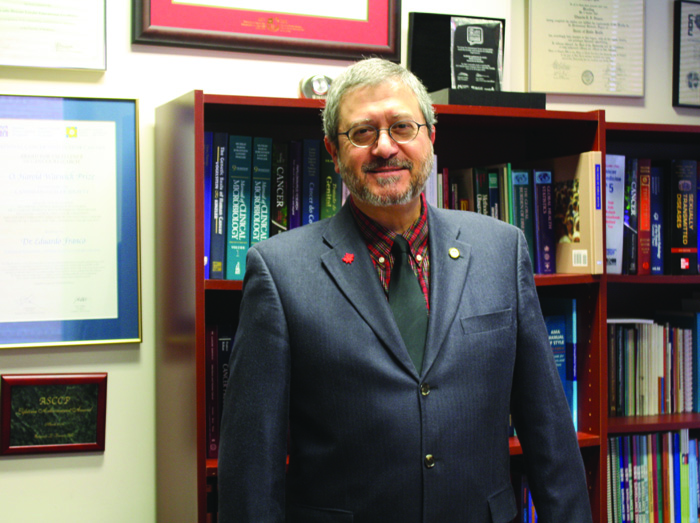To latch onto a human host cell, the human papillomavirus (HPV) scans the outside of its target until it reaches its receptor protein—the trapdoor through which the virus may pass into the cell.
The virus then proceeds to usurp the cell’s machinery in order to survive and reproduce. It is this process of hijacking that leads to an HPV infection—an incident that, according to the Centres for Disease Control and Prevention (CDC), is common to over 79 million Americans.
While HPV itself is not necessarily dangerous—in fact, it is so common that almost all sexually active men and women will receive at least one type of HPV at some point in their lives—the virus poses a threat beyond the initial infection. Depending on the condition, HPV can lead to the development of cervical and other cancers.
Unlike many cancers, however, there is a vaccine available today that can prevent both the virus and the lesions caused by it. Eduardo Franco, a professor and researcher with McGill’s Department of Oncology and Epidemiology, has focused his research for the past 30 years on developing both prevention and detection methods for the virus.
“The old Pap test, when women turn 18 and start going in for their annual test, is the sort of mantra women have had for many years,” Franco said. “[However], there are better molecular ways for us to test for [HPV]. By using a [different] approach to test for the virus, we are achieving way better sensitivity [in our studies]—our ability to detect real, pre-cancerous lesions is much better than the Pap test.”
This research front is just one of many with which the Franco lab is involved. In collaboration with students, researchers, and institutions all over the globe, Franco is pursuing many new avenues of prevention and detection, including studying the effects of the HPV vaccine, developing liquid microbicidal gels to protect against HPV, and improving the HPV detection process.
“We demonstrated that it is possible to test for the virus, but there is still a problem that women have to come to us to get screened,” Franco explained. “What if we gave them a product where they could collect the sample at home and then they could ship it in the mail, or bring it to the nurse at their own leisure?”
Franco emphasized that self-sampling would not only make the detection process easier for women, but it would also enable doctors to expand the breadth of patients that receive testing, particularly for remote areas and those populated by non-English speaking individuals.
However, one of the challenges faced by many labs like Franco’s is the difficulty of finding volunteers to participate in their various studies. Without participants, these researchers cannot extend their studies beyond the laboratory to observe how HPV functions within members of the population.
“People may be turned off by [our studies],” Franco said. “[But] at the end of the day, there is the assurance that they will contribute to generating knowledge that will help prevent infections that cause cancer and help people like themselves.”
Nikita Ber, a recent graduate of McGill’s Microbiology and Immunology program and current master’s student at the Franco lab, echoed Franco’s sentiments that many people are intimidated by the conversation about HPV.
“When people hear the term HPV, a lot of people think STIs, which makes them feel like they’ve done something [bad],” Ber said. “[However], the odds are, if you’ve had sex, you might have HPV—but fortunately it is something we can deal with today.”
He hopes that in the future, the conversation on social media will be more open towards HPV, where voices beyond those shouting about the negative effects of Gardasil—a common HPV vaccine—will also be heard.
“Yes, the vaccine may sometimes have [side effects]—like many vaccines [do]—but it also does a lot of good,” Ber said. “[Though] people don’t talk about that as much.”
Information seems to be just one of the many key aspects to continuing the uphill climb towards HPV prevention and detection. A shift in perspective, where HPV is also associated with more positive terms like ‘research’ and ‘treatment’—as opposed to ‘cancer’ and ‘STIs’—will hopefully make the topic more approachable for students considering participation in a study. Both Ber and Franco acknowledge that there is a lot of misinformation regarding the virus, which is often what leads to the surrounding fear and stigmatization.
“I always joke [about] the famous SAT question that goes as follows,” Franco said. “All Zoogles are Boogles. You see a Boogle—is it a Zoogle?’ So the analogy here is that all cervical cancers are caused by HPV infection; if you have an HPV infection, will it develop into a cervical cancer? The answer is no, the same way the answer is for the SAT question.”
Franco hopes that his current studies will continue to contribute to developing better methods of dealing with the virus.
To learn more about getting involved with HPV research, take a look at the CATCH and TRAP studies currently being conducted by the Eduardo lab.









I’m very interested in your studies. Have their been any results with this treatment?